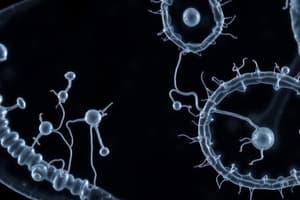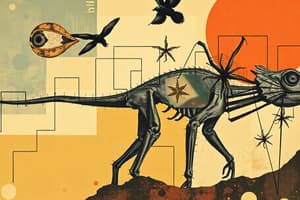Podcast
Questions and Answers
What is phylogeny?
What is phylogeny?
The evolutionary history of life and all living things on earth.
What does paleontology provide evidence for?
What does paleontology provide evidence for?
Evidence from fossils.
What is comparative anatomy?
What is comparative anatomy?
The different physical structures of plants and animals.
Define taxonomy.
Define taxonomy.
What is the Linnean System?
What is the Linnean System?
What is a binomial?
What is a binomial?
What does genus refer to?
What does genus refer to?
What is a specific epithet?
What is a specific epithet?
What are Linnean groupings?
What are Linnean groupings?
What is Plantae?
What is Plantae?
Define Fungi.
Define Fungi.
What is Animalia?
What is Animalia?
What does Protista encompass?
What does Protista encompass?
What characterizes eukaryotes?
What characterizes eukaryotes?
Define prokaryote.
Define prokaryote.
What are the characteristics of all living things?
What are the characteristics of all living things?
What is the Central Dogma?
What is the Central Dogma?
What does homeostasis mean?
What does homeostasis mean?
Define autotroph.
Define autotroph.
What is a heterotroph?
What is a heterotroph?
What is biology?
What is biology?
Define DNA.
Define DNA.
What is inheritance?
What is inheritance?
Define reproduction.
Define reproduction.
What does development refer to?
What does development refer to?
What is energy?
What is energy?
Define metabolism.
Define metabolism.
What is a stimulus?
What is a stimulus?
What is a mutation?
What is a mutation?
Define bacteria.
Define bacteria.
What are eubacteria?
What are eubacteria?
Flashcards are hidden until you start studying
Study Notes
Phylogeny and Fossils
- Phylogeny refers to the evolutionary history of life on Earth, encompassing all living organisms.
- Paleontology is the study of fossils that provide evidence of past life forms.
Classification and Anatomy
- Comparative Anatomy analyzes the physical structures of different plants and animals to reveal relationships.
- Taxonomy involves naming and classifying species into groups based on shared characteristics.
Linnean System
- The Linnean System of taxonomy assigns a two-part name to each species (binomial nomenclature) and organizes species into hierarchical categories.
- Binomial nomenclature consists of a Genus name and a Specific Epithet.
Taxonomic Hierarchy
- Linnean groupings include Family, Order, Class, Phylum, Kingdom, and Domain, which collectively represent the hierarchy of biological classification (DKPCOFGS).
Kingdoms of Eukarya
- Plantae: Kingdom characterized by multicellular autotrophic organisms that perform photosynthesis.
- Fungi: Kingdom comprising heterotrophic organisms, which can be unicellular or multicellular and reproduce asexually. Examples include yeasts and molds.
- Animalia: Kingdom of multicellular heterotrophic organisms that reproduce sexually, including various species such as dogs and cats.
- Protista: Diverse kingdom containing eukaryotic organisms that can be autotrophic or heterotrophic, unicellular or multicellular, and utilize both sexual and asexual reproduction.
Cellular Biology
- Eukaryotes possess DNA within a nucleus, while Prokaryotes lack a nucleus.
- Organisms can be classified based on their nutritional methods: Autotrophs create their own food, often through photosynthesis, whereas Heterotrophs depend on other organisms for nourishment.
Characteristics of Life
- All living things inherit DNA and consist of one or more cells, including essential biomolecules such as carbohydrates and proteins.
- Living organisms respond to environmental stimuli to maintain homeostasis and require energy to grow and reproduce.
- Evolution signifies the gradual change of species over time.
Central Dogma of Molecular Biology
- The Central Dogma illustrates the flow of genetic information: DNA is transcribed to RNA, which is then translated into proteins responsible for traits.
Basic Biological Concepts
- Homeostasis is the state of internal balance maintained within an organism for survival.
- Metabolism encompasses all biochemical reactions that facilitate energy acquisition, conversion, and utilization.
- Development involves changes from a single cell to a fully formed adult.
Genetic Changes and Stimuli
- Mutations are alterations in DNA that can lead to variations within species.
- Stimulus refers to any form of energy detected by an organism's receptors, including light, heat, and mechanical energy.
Overview of Bacteria
- Bacteria are simple prokaryotic cells without a nucleus, classified into two main groups:
- Eubacteria contains fatty acids in their membranes and is characterized by its role in various ecosystems.
Studying That Suits You
Use AI to generate personalized quizzes and flashcards to suit your learning preferences.




